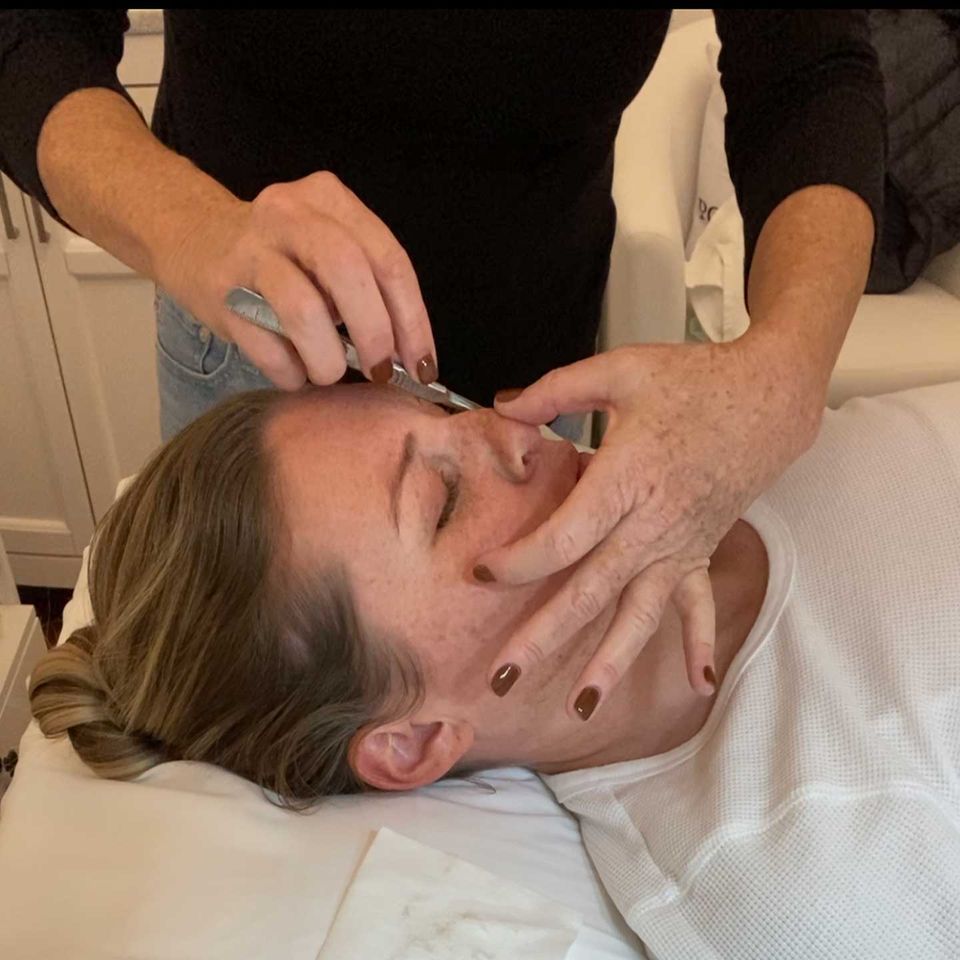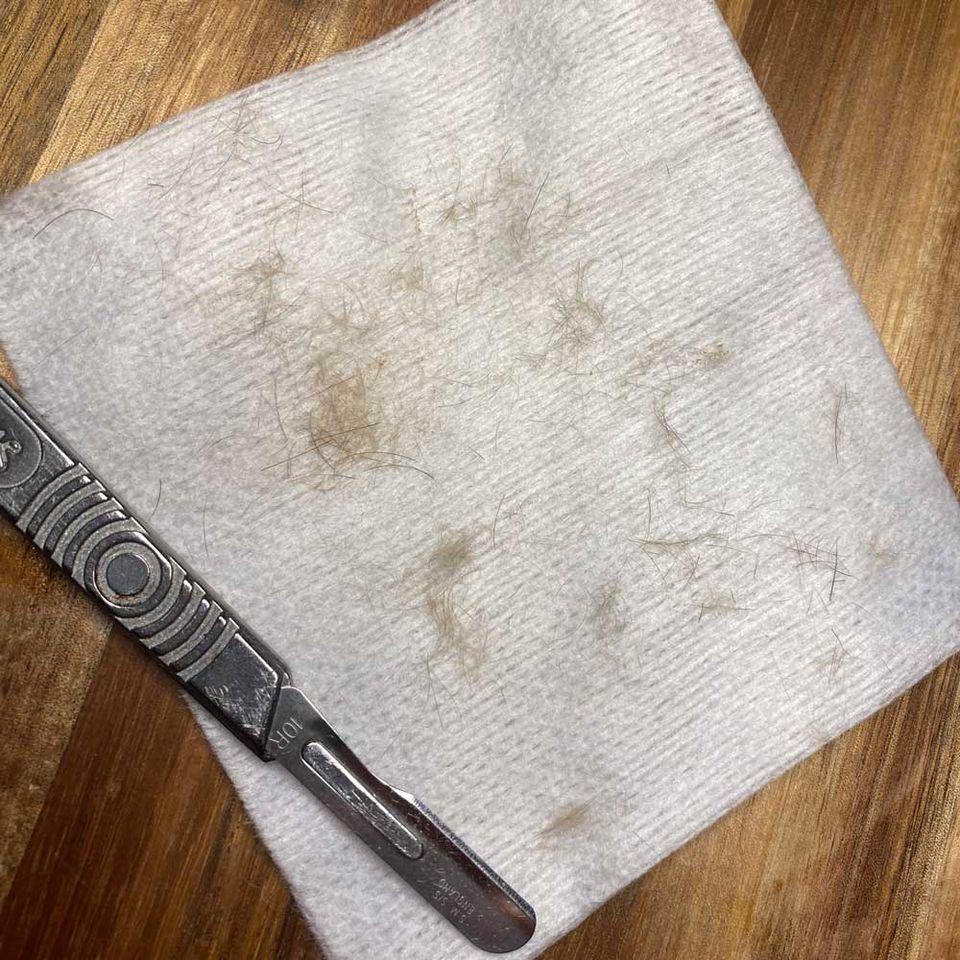

What is Dermaplaning and how does it work?
Dermaplaning is a facial treatment that involves using a medical scalpel to gently rid the skin of fine hair and dry skin. The top layer of our skin is dead skin cells. These cells build up and need to be removed for the skin to function and look its best.
What are dead skin cells?
Dead skin cells are a natural result of the skin renewal process. They can make your skin look dull and dry, and can clog pores if not removed. Dermaplaning is one way to remove dead skin cells.


Who benefits most from dermaplaning?
You may consider dermaplaning if you have skin concerns such as:
Acne scars
Actinic keratosis
Dull or dry skin
Peach fuzz
Skin damaged by sun exposure
Fine lines (wrinkles)
Acne scars
- Acne scars are a common problem that can affect people of all ages. By exfoliating the top layer of skin through dermaplaning, the deeper scars will get more shallow and your skin will appear and feel smoother.
Actinic keratosis
- Actinic keratosis is a skin condition that occurs when you have too much exposure to the sun. It often appears as a scaly patch or growth on the skin, and can be a precursor to skin cancer. Dermaplaning can help take off the build-up of these “pre-cancer” cells. Dermaplaning will help with your skin functioning in a new healthy manner.
Dull or dry skin
- Dull /Dry skin is a common problem that can make you look tired and older than you are. Many people have dry skin, especially as we age and our hormones change. Reducing the dry skin will make your skin glow and allow the products used to hydrate your skin, to penetrate better.
Peach fuzz
- Peach fuzz is a term used to describe the fine, light hair that grows on most women’s faces. While it’s not harmful, peach fuzz can make your skin look less smooth and can be difficult to remove. Dermaplaning is one way to remove peach fuzz, and can have a number of benefits for your skin.
Skin damaged by sun exposure
- Sun exposure is the number one cause of skin damage. It can lead to a variety of problems, including wrinkles, sunburn, and skin cancer. Dermaplaning can help with this type of skin and you will notice major improvements with continued treatments.
Fine lines (wrinkles)
- The appearance of fine lines or wrinkles on a person’s face can be the result of a variety of factors, including age, sun exposure, and lifestyle choices. These lines and wrinkles can make a person look older than they are, and can be difficult to remove. While there is no cure for wrinkles, dermaplaning can help even out the ridges that wrinkles cause in the skin.

Who shouldn’t have dermaplaning?
Some people with preexisting skin concerns shouldn’t have dermaplaning. Before getting this procedure, talk to your healthcare provider if you have:
Most people report a feeling of smoothness and glowing skin after dermaplaning. You may also notice that your skin is a little red right after the treatment.
This is normal and should go away within a few hours. You may also experience some peeling in the days following dermaplaning.
Continue taking good care of your skin after dermaplaning. Avoid scrubs, retinoids, and high-concentration alpha hydroxy acids for a few days to give your skin time to heal. Sunscreen is also important, as it can help protect the new layer of skin that has been exposed.
If you have dry or sensitive skin, you may want to avoid harsh beauty products and stick with gentle cleansers and moisturizers
What is the difference between dermaplaning and microdermabrasion?
Dermaplaning is a facial treatment that involves using a scalpel to gently scrape off the top layer of skin.
It’s mostly used to remove dead skin cells, but it can also help get rid of fine hair. Dermaplaning is often recommended for people with dry or sensitive skin, as it can help improve skin texture and reduce inflammation.
Microdermabrasion is also an excellent exfoliation facial treatment. Our diamond head tips gently scrape away the dead skin and suck the the dry skin through a filter.
Advanced Skincare believes both are great facials but dermaplaning can be more results- oriented than Microdermabrasion.
Some people with preexisting skin concerns shouldn’t have dermaplaning. Before getting this procedure, talk to your healthcare provider if you have:
- Active acne
- Cold sore outbreaks
- Moles, freckles, skin tags or other skin growths
- Skin burns, such as those from radiation therapy
- Skin rashes such as contact dermatitis
- Eczema or Psoriasis
Most people report a feeling of smoothness and glowing skin after dermaplaning. You may also notice that your skin is a little red right after the treatment.
This is normal and should go away within a few hours. You may also experience some peeling in the days following dermaplaning.
Continue taking good care of your skin after dermaplaning. Avoid scrubs, retinoids, and high-concentration alpha hydroxy acids for a few days to give your skin time to heal. Sunscreen is also important, as it can help protect the new layer of skin that has been exposed.
If you have dry or sensitive skin, you may want to avoid harsh beauty products and stick with gentle cleansers and moisturizers
What is the difference between dermaplaning and microdermabrasion?
Dermaplaning is a facial treatment that involves using a scalpel to gently scrape off the top layer of skin.
It’s mostly used to remove dead skin cells, but it can also help get rid of fine hair. Dermaplaning is often recommended for people with dry or sensitive skin, as it can help improve skin texture and reduce inflammation.
Microdermabrasion is also an excellent exfoliation facial treatment. Our diamond head tips gently scrape away the dead skin and suck the the dry skin through a filter.
Advanced Skincare believes both are great facials but dermaplaning can be more results- oriented than Microdermabrasion.

Frequently Asked Questions
How often should you dermaplane?
Most people should dermaplane around once a month. It all depends on your individual skin type and needs. Talk to your esthetician about what’s best for you.
What type of dermaplaning procedures do you offer?
We offer two types of dermaplaning facials:
#1 Hybrid dermaplaning facial is a 60 minute procedure. Included are an enzyme treatment, LED light therapy and a full facial. This treatment is our most requested facial.
#2 Express dermaplaning is 25 minutes and is a great exfoliating “in and out” facial. This is a great service when you are short on time
Does dermaplaning cause stubble?
No, dermaplaning does not cause stubble. The soft, fine hair will grow back just as it was. It’s a myth that dermaplaning causes coarse hair growth.
Is dermaplaning the same as shaving?
Yes and no. The removal of hair is basically the same however, we also can get layers of dry skin off that razors cannot do. We use a very sharp instrument to go much deeper than shaving.
Do you have any dermaplaning before and after pictures?
Most people should dermaplane around once a month. It all depends on your individual skin type and needs. Talk to your esthetician about what’s best for you.
What type of dermaplaning procedures do you offer?
We offer two types of dermaplaning facials:
#1 Hybrid dermaplaning facial is a 60 minute procedure. Included are an enzyme treatment, LED light therapy and a full facial. This treatment is our most requested facial.
#2 Express dermaplaning is 25 minutes and is a great exfoliating “in and out” facial. This is a great service when you are short on time
Does dermaplaning cause stubble?
No, dermaplaning does not cause stubble. The soft, fine hair will grow back just as it was. It’s a myth that dermaplaning causes coarse hair growth.
Is dermaplaning the same as shaving?
Yes and no. The removal of hair is basically the same however, we also can get layers of dry skin off that razors cannot do. We use a very sharp instrument to go much deeper than shaving.
Do you have any dermaplaning before and after pictures?
